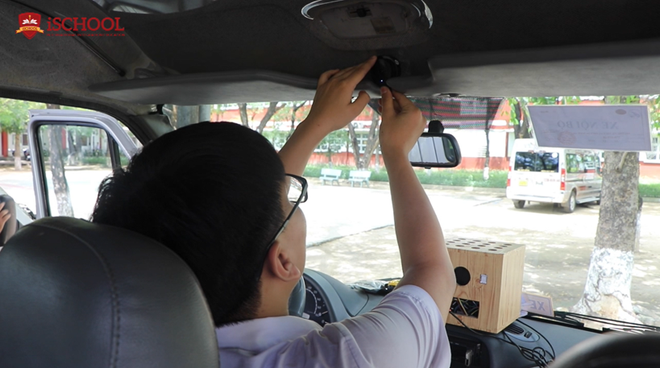Many outstanding projects from Samsung Solve for Tomorrow have been put into practice, contributing to solving community issues, such as the student-developed device to prevent children from being left behind in cars from iSchool International Integration School.

Originating from tragic incidents, a group of students from iSchool Quy Nhon researched and developed a device that warns when children are left behind in cars, while also supporting monitoring of drivers’ sleep. The project won a Consolation Prize in the Samsung Solve for Tomorrow 2022 competition and is now being tested on student shuttle buses at iSchool Quy Nhon, with plans to expand implementation across the iSchool system nationwide.
From painful reality to technological solution
According to the Kids and Car Safety Association (KSC), from 1990 to 2023, the United States recorded 1,083 children dying of heatstroke after being left in cars, an average of 38 cases each year. In other countries, the figures are also alarming: 4–5 cases annually in China, 3–4 in Israel, and 2–3 in Australia. In Vietnam, several similar accidents have occurred, raising urgent alarms about the need for preventive measures.
Efforts to address this issue are being researched and implemented by many individuals and organizations, including solutions applying advanced technology. One notable project is the “Development of a smart device that warns and makes support calls when children are left in cars, and monitors drivers’ sleep in unsafe air conditions” - an initiative by iSchool Quy Nhon students.
The project originated from the concerns of Nguyen Bao Loc and Dinh Phong, then 9A2 students. With the encouragement and guidance of their teacher, Huynh Thi Kim Tuyet, an Information Technology teacher at the school, the two bravely registered to participate in the Samsung Solve for Tomorrow 2022 competition under the team name Dream.
Throughout the competition journey, the Dream team received support from the organizers, from STEM knowledge, design thinking, project planning, to essential soft skills. “When participating in the competition, we could freely create and design the product. In particular, the experts trained and guided us enthusiastically from when the project was just an idea until it became a real product,” Bao Loc shared.
The device developed by Dream has two main functions. First, to warn and call for help when a child is left behind in the car. When sensors detect signs of life after the driver has left, the device will sound an alarm and call a pre-set phone number. Second, to monitor temperature and air quality in the car when the driver is sleeping. The integrated sensors will warn if the temperature or carbon monoxide (CO) levels exceed safety thresholds.
Dinh Phong said: “When participating in Samsung Solve for Tomorrow 2022, we overcame many challenges to complete the project, from programming the device, testing sensor sensitivity, to running trials on simulated vehicles. Other teams also had many creative products, but that motivated us even more to perfect our device.”
“Stepping out” to serve the community from a competition prizei
Although only winning a Consolation Prize, the Dream team did not stop there. After the competition, the group continued to improve, increasing sensor sensitivity, reducing false alarms, and upgrading the air filter from experimental scale to practical use.
Notably, the project received support from their own school, as the device is now being piloted on student shuttle buses at iSchool Quy Nhon. This opens opportunities for broader deployment on buses across the nationwide iSchool system.
Nguyen Thai Tung, a school bus driver, shared: “Since knowing this device was installed for testing on the bus, we feel much more secure. It not only protects students but also makes us drivers safer.”
Teacher Huynh Thi Kim Tuyet also affirmed: “Samsung Solve for Tomorrow is not only a competition but also a launching pad for students to create and generate practical value. The success of the Dream team proves that when students are given access to technology and systematic guidance, they can solve real-life problems.”
In addition to the Dream team’s device, many other outstanding projects from Samsung Solve for Tomorrow are also being implemented in reality, contributing to solving community issues, such as: a smart water filtration system using solar energy to provide clean water for rural areas; an IoT-based device to detect and handle dust concentration in coir fiber and coconut husk production facilities; equipment to support soaking, incubating, and caring for rice, while providing disaster alerts for smart agriculture; research, design, and creation of Agro Robot – monitoring, supervising, and assessing the health of rice-growing soil in Hau Giang; waste sorting and conversion systems using AI and IoT; devices warning of risks to children at high-rise balconies…
The Samsung Solve for Tomorrow competition was initiated globally by Samsung in 2010 and has since been implemented in 66 countries.
Not only a scientific playground, the program also helps students sharpen soft skills through training in problem-solving, time management, creative thinking, teamwork, and presentation. Competing teams are mentored by leading technology experts from Samsung and major universities, enhancing their research mindset and ability to turn ideas into reality.









